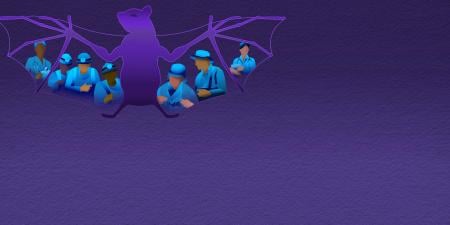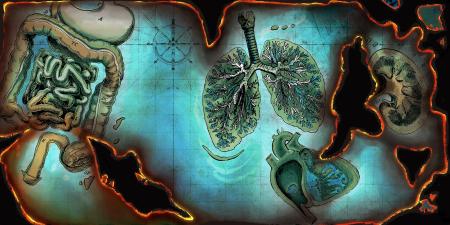Abstract
This article considers lessons about American (individual-centered) anthropocentric (human-centered) thinking that can be applied to how we confer dignity and moral status to beings other than humans. Interestingly, global bioethics might glean such lessons from fungi.
Mushrooms in the Moment
Mushrooms are having a cultural moment. Last year on Halloween, I dispensed wee chocolate bars to an adorable 4-year-old dressed as Amanita muscaria, a kind of mushroom often represented in fairytales as “toadstools” easily recognized by their white-spotted red caps and white stems.1 The fact that some fungi, including this one, produce psilocybin is probably another socially relevant reason why mushrooms appear on various fabrics and at our doors for trick-or-treat. There are also ecological reasons to conjure wider recognition of the importance of fungi and other beings with which we co-inhabit the world.
Networks
Mycelia give literal, physical structure to human existence by forging underground linkages among roots and through soils in diverse ecologies in which human and nonhuman animals, plants, fungi, and other microbes (eg, bacteria and viruses) are enmeshed. A single mushroom is one fruiting body—a fungal flower, one might say—that grows from a larger, mostly underground, mycelial network known by some as the “wood wide web.”2 A mushroom’s appearance as a discrete entity seems to perpetuate what we might construe as a particularly American—prone to be hyper individualist—kind of anthropocentric (human-centered) illusion that these organisms’ most prominent form of selfhood emerges and exists in the world as an individual and as mainly for human benefit. But, really, fungi can be huge communities that benefit many species.
Perhaps it’s worthwhile to indulge our tendency toward anthropocentrism for a moment to consider how humans specifically benefit from fungi. Fungi are among the many microbes that enable us to live by inhabiting our guts and other sites in and on our bodies. Fungi can also inhabit or host other organisms that flourish in and on each other.2 We rely on and are part of these networks, despite our nodes of interconnection remaining invisible, unknown, or unbelievable.
Questions fungi prompt humans to ask include:
- What does it mean, ecologically and ethically, to be an individual?
- What are the most ecologically important consequences of an American anthropocentric tendency in ethical reasoning to confer dignity or other kinds of moral standing on individuals rather than on communities and on humans rather than on a broader range of species?
Dignity
One lesson for humans, especially those of us working in health care ethics, from fungi—and from One Health, a key theme of this February 2024 theme issue—is that we might do better as a species to think of many, if not all, fungi, plants, and nonhuman animals as having dignity because they have places in the world, because they inhabit ecological niches. If species’ members’ ecological niches are viewed as key ethical sources of their and our dignity, we can more robustly acknowledge how the needs of the landscapes we co-inhabit underlie our pressing need to be humble about our limited capacity to respond to our shared problems, especially existential ones, as a collective.
Humans have much to learn from other species about collective intelligence, for example. Many bird species have evolved in ecological niches to express collective intelligence that humans have not evolved to express. Snowy owls reliably regulate their reproduction trends according to availability of resources, particularly lemmings.3 Humans, however, tend to think of reproductive responsibility mainly in terms of individual family resource access, a kind of reasoning with ecological impact far beyond individual family units. Other bird species, such as European starlings, and many fish have evolved group-based aerial or aquatic coordinated movement—called murmuration—that protects most in their flocks or schools from predation.4 Humans can collectively choreograph for the sake of music, dance, labor strikes, or military operations, but our track record of success in coordinating group actions that motivate resource or survival interests for most of our species is not well established, especially in the years following large-scale, intentional decimation of First Nation ways of being in the world.
Despite its advantages to humans, anthropocentrism has become its own threat to humans’ continued existence.
And there are more good reasons to consider expanding dignity’s scope of applicability beyond humans. But first, of course, there’s a good question we need to ask about such expansion: Should we regard Candida auris, anopheles mosquitoes, or head lice as beings with dignity or as beings with some other kind of ethical value, as ends in themselves? Despite anthropocentrism’s obvious speciesism, we must give anthropocentrism its due, if only because it has, unsurprisingly, motivated gains in human health. Perhaps anthropocentrism serves a purpose of reminding us that if we enlarge dignity’s tent to accommodate the interests and stakes of more and a more diverse range of beings, then we must also think carefully about the nature and scope of legal rights, ethical goods, and just deserts that dignity confers on so many beings.
Yet, it need not follow from expanding dignity’s tent that everyone or everything under that tent deserves the same expressions of respect for their dignity in different circumstances. What does follow is that we are obliged to carefully consider how we assign the legal rights, ethical goods, and just deserts of dignity, to which organisms, when, and why. A caution, to be clear, is that, as a species, humans can probably no longer afford to see their health interests through anthropocentrism’s microscopic, myopic lens. Despite its advantages to humans, anthropocentrism has become its own threat to humans’ continued existence. One reason for this is that human health does not, has not, and never will stand on its own. Our health relies on ecological well-being, even when we don’t know it or believe it.
Humility
Let’s suppose a likely case that illustrates the irrelevance of what humans know or believe about their own health: there’s a microbe yet unknown to science with key functions in Earth’s ecosystems that are also yet unknown.5 In the absence of ecological knowledge about Earth’s communities’ everyday operations, even the staunchest anthropocentrist has good practical reasons (eg, what you don’t know might hurt you, what you don’t know now but learn later could help you) to broaden conceptions of dignity to a broader range of beings with which we live. Even in the case of a microbe known to pose human pathogenicity, if that microbe has known or even unknown roles in Earth’s ecosystems, the ethical and intellectual value of epistemic humility—respect for what we don’t know or know little about—helps us discern what would still be those same practical reasons to center human health in our reasoning about which beings we confer dignity on.
We Owe Beings We Don’t Know
An ethical and ecological merit of expanding eligibility for dignity is that, even when such pathogens threaten humans or our livelihoods, if such organisms have evolved to occupy important ecological niches or to occupy ecological niches whose importance is unknown to us, we should ask, What are the smartest ways for us as a species to express epistemic humility? It could be that expressions of epistemic humility and expressions of respect for the dignity of our ecological co-inhabitants turn out over time to be ethically and ecologically convergent. If we fail to express epistemic humility in our reasoning about dignity, we ought to be worried about what that says about our individual characters in addition to its consequences for our communities and species. At the very least, the limited scope of what little humans know about our microbial co-inhabitants’ lives does not seem to justify the scope of decimation we’ve wrought on fellow species to motivate the ends and interests of humans, especially a few humans of great privilege.
If and when we do learn to express more thoroughgoing respect than we have in the past for our enmeshment, for our “entangled life,” in the words of the biologist Merlin Sheldrake,2 then we equip ourselves to more fully and powerfully think about and enact what we owe each other and what we owe all beings of ethical and ecological value, known and unknown, as we try to make good in and on the exchanges global bioethics requires.
References
-
US Forest Service. Fly agaric. US Department of Agriculture. Accessed October 30, 2023. https://www.fs.usda.gov/wildflowers/ethnobotany/Mind_and_Spirit/flyagaric.shtml
-
Sheldrake M. Entangled Life: How Fungi Make Our Worlds, Change Our Minds, and Shape Our Futures. Bodley Head; 2020.
-
Snowy owl: Bubo scandiacus. Owl Research Institute. Accessed October 30, 2023. https://www.owlresearchinstitute.org/copy-of-snowy-owl
-
Alfano A. How do starling flocks create those mesmerizing murmurations? February 21, 2013. Accessed November 3, 2023. https://www.allaboutbirds.org/news/how-do-starling-flocks-create-those-mesmerizing-murmurations/
-
Bakalar N. Earth may be home to a trillion species of microbes. New York Times. May 23, 2016. Accessed October 30, 2023. https://www.nytimes.com/2016/05/24/science/one-trillion-microbes-on-earth.html#:~:text=According%20to%20a%20new%20estimate,have%20yet%20to%20be%20discovered



